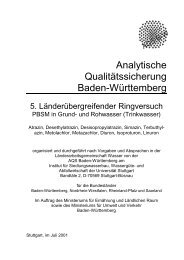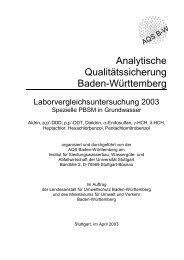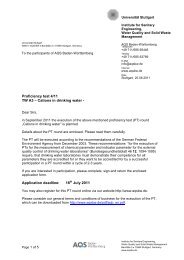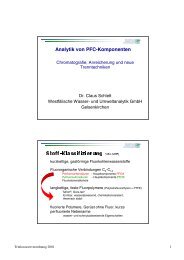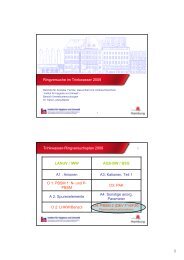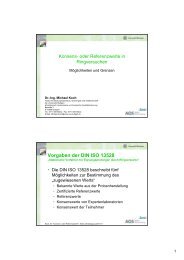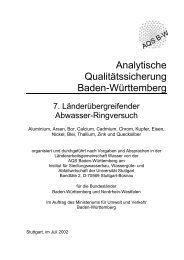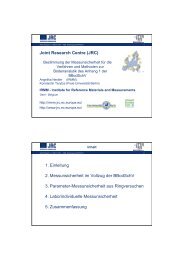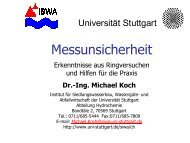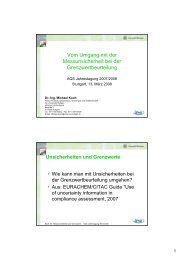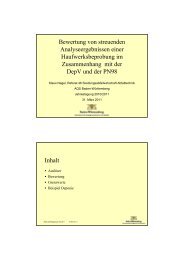Institute for Sanitary Engineering, Water Quality and Solid Waste ...
Institute for Sanitary Engineering, Water Quality and Solid Waste ...
Institute for Sanitary Engineering, Water Quality and Solid Waste ...
Create successful ePaper yourself
Turn your PDF publications into a flip-book with our unique Google optimized e-Paper software.
<strong>Institute</strong> <strong>for</strong> <strong>Sanitary</strong> <strong>Engineering</strong>, <strong>Water</strong> <strong>Quality</strong> <strong>and</strong> <strong>Solid</strong> <strong>Waste</strong> Management<br />
Simulation <strong>and</strong> nonlinear control of anaerobic<br />
digestion<br />
Anaerobic digestion represents a valid option in the<br />
treatment of organic waste, providing a solution <strong>for</strong><br />
its disposal <strong>and</strong> the simultaneous production of green<br />
energy. However the process is considered problematic<br />
<strong>and</strong> tends to instability due to acidication. Process<br />
control can improve the stability of the system keeping<br />
the acid concentration within safety limits, while permitting<br />
a regular <strong>and</strong> sustained production of methane.<br />
The scope of this work is the development <strong>and</strong> test<br />
of a nonlinear control strategy <strong>for</strong> anaerobic digestion<br />
using reliable virtual laboratories or \simulators“. The<br />
work proceeded through two major steps:<br />
Industrieverlag GmbH, 2009. (Stuttgarter Berichte<br />
zur Abfallwirtschaft; Bd. 96), 85 S., 34 Abb., 24 Tab.,<br />
ISBN 978-3-8356-3191-5<br />
1. the implementation <strong>and</strong> calibration of a nonlinear<br />
anaerobic digestion model to test the capability of<br />
reproducing the dynamical behaviour of a real system;<br />
the model chosen is the detailed ADM1 [13],<br />
implemented in the software Matlab ® <strong>and</strong> calibrated<br />
<strong>for</strong> the simulation of three real cases: a biowaste<br />
reactor, a cofermentation reactor <strong>for</strong> sludge <strong>and</strong><br />
kitchen waste <strong>and</strong> a surplus sludge fermentation<br />
process. In the latter case a detailed parameter estimation<br />
procedure is implemented.<br />
Simulation model of fermentation<br />
2. the design, implementation <strong>and</strong> tuning of a nonlinear<br />
adaptive control algorithm, using the feedback<br />
linearisation method; the control system is tested<br />
on simulated plants, a co-fermentation reactor <strong>for</strong><br />
corn silage <strong>and</strong> cow manure <strong>and</strong> the biowaste reactor<br />
simulated in the previous section.<br />
The results of the work are very encouraging: the control<br />
system is able to reject the disturbances acting on<br />
the feed of the process while maintaining a sustained<br />
biogas production. The tests on the simulated systems<br />
are a valid alternative to costly <strong>and</strong> time-consuming<br />
experimental work, <strong>and</strong> can be considered reliable, if<br />
the model has been properly calibrated to the real system.<br />
Doctoral c<strong>and</strong>idate: Carla Cimatoribus<br />
Principal examiner:<br />
Prof. Dr.-Ing. Martin Kranert<br />
Secondary examiners:<br />
Prof. Dr.-Ing. Eckhard Kraft<br />
Prof. Dr.-Ing. Renatus Widmann<br />
Carla Cimatoribus<br />
Simulation <strong>and</strong> nonlinear control of anaerobic digestion<br />
(2009), Forschungs- und Entwicklungssinstitut für<br />
Industrie- und Siedlungswasserwirtschaft sowie Abfallwirtschaft<br />
e.V. Stuttgart (FEI). München: Oldenbourg<br />
Comparison between experimental <strong>and</strong> predicted variables<br />
with the estimated parameters<br />
The bacterial degradation of halogenated <strong>and</strong><br />
methylsubstituted aromatic mixtures <strong>and</strong> its application<br />
in biological waste air treatment<br />
Methyl- <strong>and</strong> halogen substituted aromatics are widely<br />
used in industrial processes as educt <strong>for</strong> the production<br />
of o-cresol, agro-chemicals, flame retardants, dyes,<br />
varnish <strong>and</strong> pigments, textile additives, pharmaceuticals,<br />
adhesives, polymers <strong>and</strong> resins, air fresheners,<br />
drain cleaners <strong>and</strong> optical brighteners. Furthermore, it<br />
is used as solvent <strong>for</strong> agro-chemicals, in heavy metal<br />
industry, paint thinners, heat conductable oils as well<br />
as condenser liquids <strong>and</strong> is used as additive <strong>for</strong> fuels.<br />
Depending on the specific aromatic compound about<br />
5- 15 % of the world production per year is set free<br />
into the air or water. Especially in case of the waste<br />
air high volumetric flows with low carbon freight occur.<br />
Thus, biological treatment techniques are the first<br />
choice as treatment procedure.<br />
66




